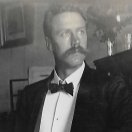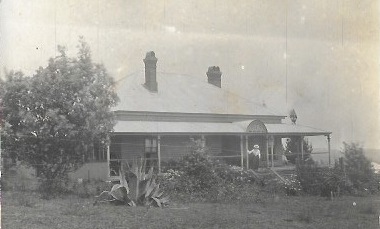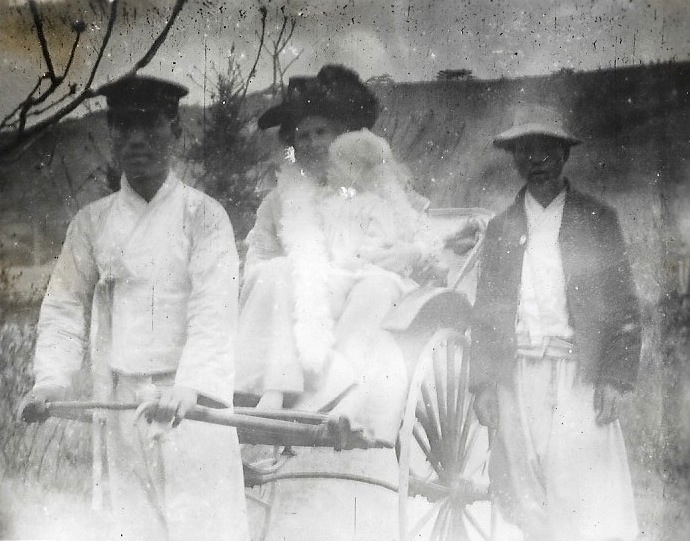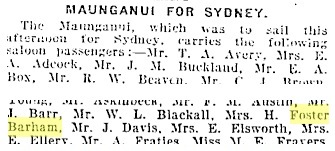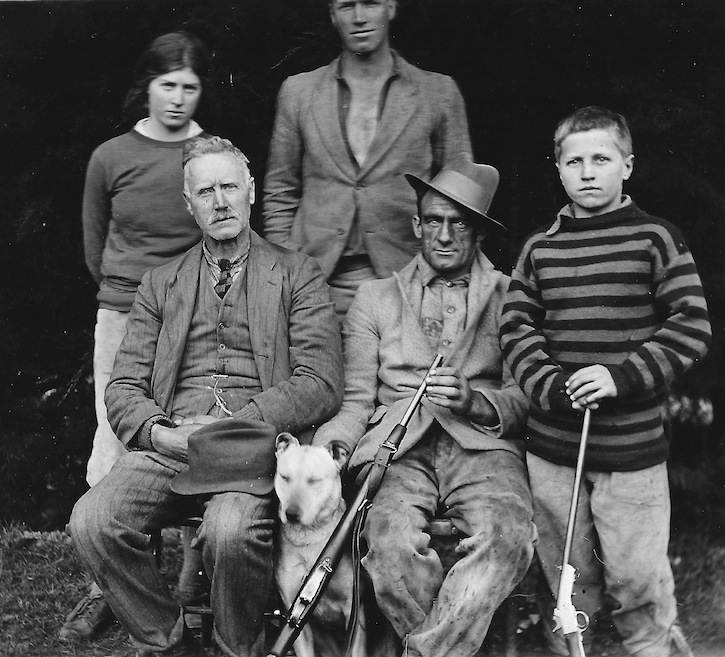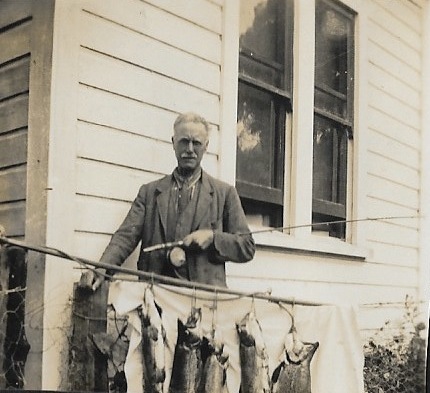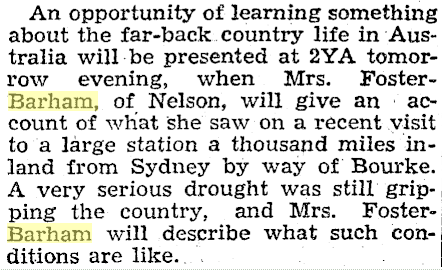Hugh was born in England. He was educated at Berkhamsted (a Public School founded in 1541 with licence by King Henry VIII). He went on to university to study civil engineering at the Crystal Palace Practical School, as well as in Leipzig (Germany). Later, he gave lectures at Crystal Palace.
The Foster Barham family motto was Si Fractus Fortis (if broken, still strong).
Granddaughter Aroha (APFB) relates: His great friend was his cousin Helen (D'Oyly) Carte (her mother was Ellen Barham; from Wikipedia on Helen). She gave him tickets to the Gilbert & Sullivan shows in London. (She passed her Math exams at London University but as a woman she could not get a degree in that field.)
He became water-works engineer. On February 18th, 1891, he read a paper before the Liverpool Engineering Society about foundations to buildings, when made in the dry or when under water. In 1893, on Feb. 7th, he was elected as Associate Member of the Institution of Civil Engineers. In 1895 he considered aspects of a new shipping canal for Bridgwater and the river Parrett: "Navigation of the River Parrett - Proposed Ship Canal to Bridgwater" (the tides of the Bristol Channel reach up to Bridgwater).
|
|
Other items: In 1892 he gets a commission as "second lieutenant". And in 1895 he wins 25 Guineas. Some details can be found in the clippings HGFB and MMC.
In between jobs, he worked for his father at the brick works in Bridgwater.
|
Around that time, Hugh must have bought a photographic camera. His photo books, some of which survive with his granddaughter Aprilla (hereafter referred to as pAJnS), have only photos from later than ca. 1893. Hugh assembled the photos later in life into books and the photos are only partly in chronological order. One book was prepared for his daughter Margaret in 1940 after she had married Owen. Many photos are from 1900 to 1904, while certain later periods are reasonably well represented. The photo book with large photos from around 1894 deals mostly with his immediate family in England. |
In Australia he was engineer for the Brisbane Board of Waterworks,
for which he did a thorough investigation of the problems of the water supply.
According to
![]() in journalistic items well worth reading, of
24th July 1901
and of
17th July 1902,
his reports were quite critical of the Boards plans for water filters but
also of the general views of the Board.
(The Brisbane Courier gives, on
page 6,
a summary of that Board meeting, in which the
author of the report is indicated only as "the engineer".)
But his report appears, also in hindsight (an analysis published in 2011),
to have been very relevant.
in journalistic items well worth reading, of
24th July 1901
and of
17th July 1902,
his reports were quite critical of the Boards plans for water filters but
also of the general views of the Board.
(The Brisbane Courier gives, on
page 6,
a summary of that Board meeting, in which the
author of the report is indicated only as "the engineer".)
But his report appears, also in hindsight (an analysis published in 2011),
to have been very relevant.
Hugh designed and had constructed the first dam upstream from Brisbane
to protect the town and its environs from the repeated floodings.
A plaque at the dam also has his name.
|
|
Margaret (Meta) was born at the farm Uanda in NW Queensland, Australia. She grew up at Uanda, in Toowoomba, Queensland, and on the farm called "Aughamore" just west of Toowoomba. She and her parents often came in Toowoomba, where grandmother Margaret and other relatives lived or visited in summer.
Her granddaughter Aroha (APFB) recounts:
Meta (and her sister Helen) were sent to a Presbyterian Ladies
college in Melbourne. (Helen was head-girl.)
They wrote poetry and played the piano.
I think she might have had red hair.
An auburn plait was found after she had died.
(Isobel and one of her brothers had red hair, too.)

|
Left: Meta at Burleigh Heads,
|
Hugh met Meta in 1901.
Numerous photographs were taken showing the life of well-to-do families,
with outings (e.g., to the beach at Burleigh Heads, SSE of Brisbane),
to relatives living in and beyond Toowoomba and photos of sporting activities.
Hugh and Meta married in Toowoomba in St. Stephens church in 1903,
Hugh being 36, Meta 20 years old.
They then lived in "Durante" in Toowoomba.
Their first two children were born in Australia.
Children: 1904 (in Queensland, Austr.) Elizabeth Patricia (Betty), Alfred (+1930, fell from horse in Aldershot); in Seoul, Korea: 1908 Justin Beachamp (1933 x Phyllis Edith Burton), 1910 Mary Catherine; in Genoa, Italy: 1913 Margaret Moore, Williamina (Min), Thomas (+1942 WW II).
One of Hugh's photobooks has photos of the construction in 1903 of a new concrete wall at the Mount Crosby pumping station on the Brisbane river.
Korea had become, in 1905,
after the Russo-Japanese war, a Japanese "protectorate".
Around 1905, the city of Seoul, Korea, initiated the construction of
Waterworks for Seoul.
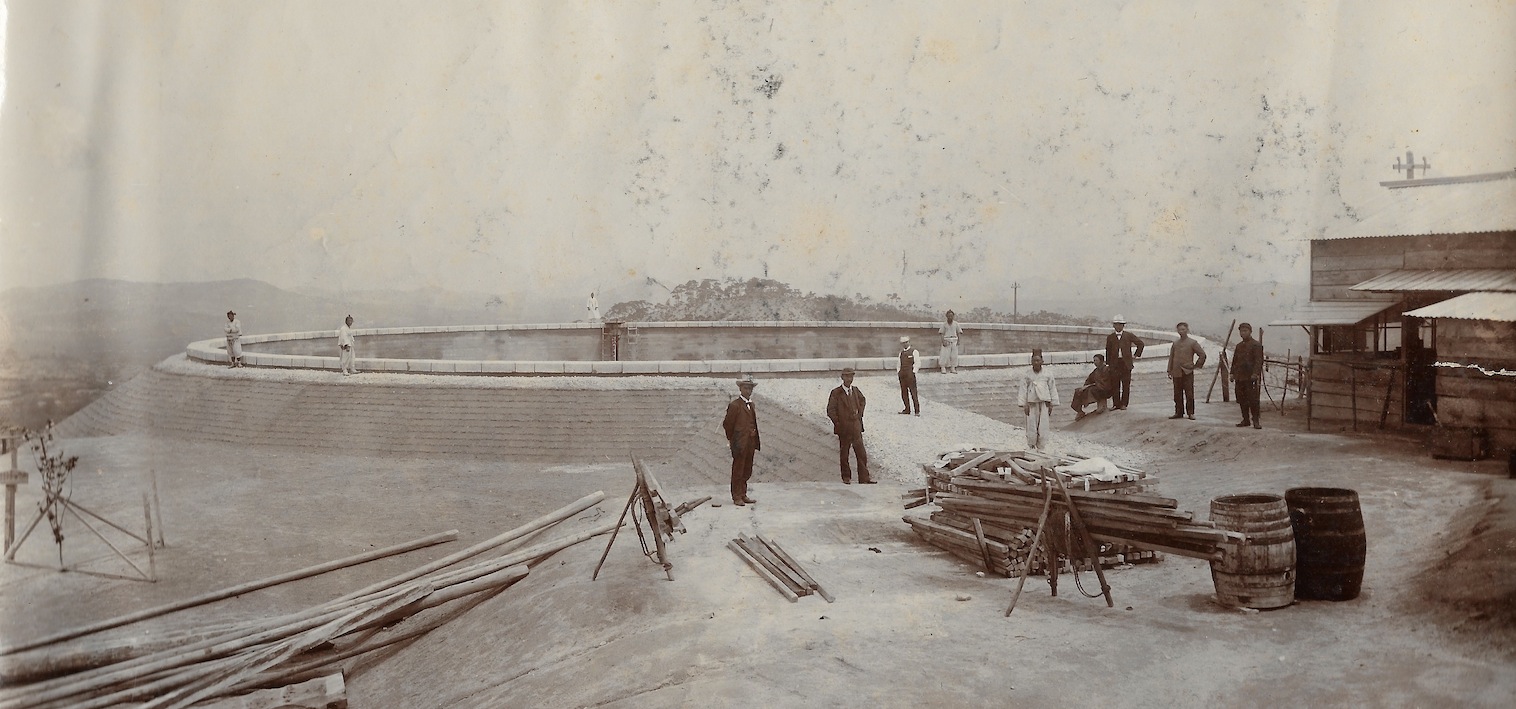

|
In the publication of 1908 of the Institution of Civil Engineers Hugh is listed as associate member (p.139) with the address: Barham, Hugh Garratt Foster, Korean Waterworks, Seoul, Korea. The Seoul waterworks (see 2 images) became operational in 1908. After almost a century the building was turned into a museum.

|
APFB: Meta taught English to the Korean Royal family. This proximity resulted in that family opening the waterworks where Hugh could take a photo, apparently the only photo known of the Royal family.
Several of Metas letters from Seoul have been preserved (see MCR p.114ff). Feb. 3rd, 1907: We have just got back from having a very jolly afternoon on the ice. For the first time I have been able to go along at a good pace, and really enjoy it. Miss Shore gets her turns at it, but we are never both away from the children at once. I utterly disapprove of the way the mothers neglect their children here and leave them almost entirely to nurses. We are having a very cold spell indeed, the thermometer below zero every evening. About 35 degrees of frost which is pretty cold. The air, however, is so delightfully dry and soft that one does not feel it and Baby sleeps out in his basket when the thermometer is standing at 12 degrees frost. When the winds come over across Siberia, it is very cold and disagreeable, but fortunately we usually have calm weather. [Temperatures in Fahrenheit; the "Baby" ist Justin.]
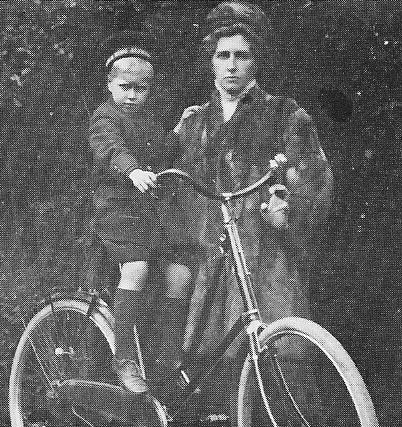
|
Meta with son Alfred in England; ~1910 |
The family escaped from Korea, before the 1910 invasion
by the Japanese army would have made it impossible.
After Korea, they were briefly in England.
They then owned a house in London.
Hugh was in 1912 asked (for the second time) to review and inspect
exam results in the Mechanical Section of his former school,
the "Crystal Palace School of Engineering".
From that time exists a photo of Meta with son Alfred.
Meta wears a fur coat.
Her granddaughter Aroha (APFB) recounts:
As Meta was high up in the Rudolf Steiner Philosphy,
she gave lectures in the "big" houses in England.
They gave her their cast-off designer clothes which she then had cleaned,
altered and adapted by dressmakers for herself and for her daughters.
Hugh continued to work as engineer, also for the army, with several stations all over the world. Since he went from job to job, he has not been employed continuously.
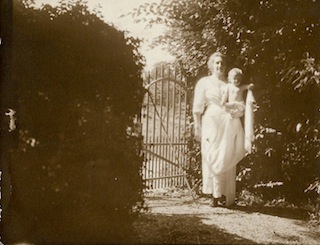
|
Margaret Moore (2x): mother and daughter, 1913, La Ballotte, Geneva;
|
Daughter Margaret was born in Genoa, Italy, in 1913. In HSM there is the following paragraph: At the time of Margarets birth, Meta nearly died. Two doctors examined her, and then went downstairs to the kitchen, where they told Hugh "She is dying". He went upstairs and said "They say you are going to be perfectly alright, Meta". She replied "They didn't say that, but I am going to live".
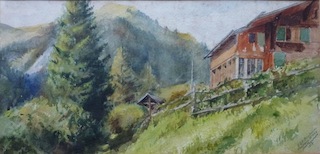
|
But it were hard times there, during the World War (photos 1916). Meta had to fend for herself and the boys would hunt birds and cash fish for food. They also grew vegetables and apples. APFB: She therefore also sold the fur coat, to a Jewish lady.
But then they are again in England. In Who's Who in Engineering of 1922 his address is 38 Angles Road, Streatham (south of London; see 1922).
Hugh always took great care of his looks, on photos his clothes are
immaculate.
When he travelled, it was in 1st class so that he could meet people
perhaps useful for later in life.
He did so as well when his wife and children traveled with him,
but they then had to travel 2nd class.
Hugh was a great entertainer (often sat at the captains table),
was good at sports, and he played the violin.
He actually was good at everything, which made him, at times,
not easy to live with.
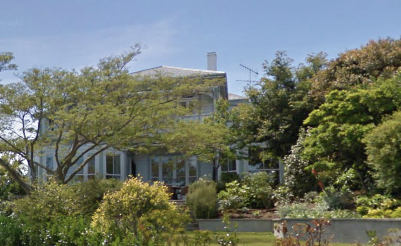
|
After the international career they moved around 1922 to Nelson,
New Zealand, in the house "The Pines" on 95 Queens Road.
The house had about 5 acres of land overlooking Tasman Bay,
Nelson and the port.
APFB recounts:
The cost of educating the children and keeping up appearences possibly
prompted them to come to New Zealand.
It was also much closer to Australia so that Meta could go and see her mother.
And indeed, she made several trips to Australia,
the first one documented in 1929
(see clippings NZ).
Hugh was semi retired. He hoped to be involved in putting in the Nelson water works, however, he did not get the job.
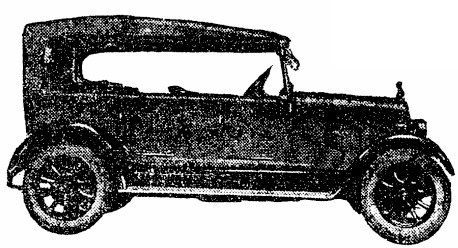
|
Hugh owned a special car, an "Arrol-Johnston" (image from an advertisement in the Evening Post, 23 Oct. 1925). Hugh had worked at the Arrol-Johnston factory when it built aircraft during WW I. When the grandchildren were older, he would take some of them for a ride.

|
Granddaughter Aroha (APFB): He had been a good figure skater, I remember the cups he had won. He also was good at bridge and chess (he played in Nelson with Algernon Burton, and that is how my parents met). He was a good water-colourist and belonged to the Nelson Suter Art Society.
His typewriter could not be touched by anybody except himself. He loved writing to many people and kept in touch with the family. In Nelson he used it also to write "Letters to the Editor" of the Evening Post.
Aroha (APFB):
He was a good gardener, he grew lots of vegetables in a covered garden.
There were also lots of fruit trees, among them 6 lemon trees.
They kept a cow for milk and a horse to ride - for the girls.
And there was a gig.
One story:
Min [Williamina] would play the violin - Irish tunes.
Somebody would drive the gig, and one collected a lot of friends,
so off they'd go for a swim in the river, like the "Pied Piper".
|
|
MCR remembers her Aunt Meta (in the late 1930s) as follows (MCR p.117):
I thought her an absolutely fascinating person when she entered our
lives as children.
That was during the great depression, when my father had a farm on
the Darling Downs [and Meta came from New Zealand to visit us.
Dad [Donald Cameron] went to get her by car from Toowoomba.]
I can still see the two of them arriving, late in the day,
under leaden skies. Dad and the sister he had not seen for years.
They were standing together on the pig cart, right inside the frame,
as Dad came rattling over the stony ridge to our gate.
She was a tall, splendid beautiful woman, dressed in English country
tweeds of a Bond Street look.
Even her hair and skin somehow looked as if bought in Bond Street.
Their faces were bright with laughter, and fresh with the cold air.
She had tied an expensive Scottish scarf around Dad's leathery throat
to keep out the cold -
an object he would not have consented to wear for anybody else, I am sure.
Some further "events" in the lives of Hugh and Meta:
- 1930. Son Alfred,
who had won a military scholarship to Cambridge, died.
For his military training he was at Aldershot, England,
where he fell from a horse, broke a leg,
and died five days later of his injuries.
|
|
|
- 1931. Daughter Margaret passes the university entrance exam. She will go to Dunedin.
- 1935. Hugh also spent time hunting and fishing. In 1935 he was at the Mangles River near Murchison, some 100 km inland from Nelson. He had himself photographed with a 35 lb catch. And in 1937 Hugh and Meta spent a fortnight in Geraldine because Hugh went fishing there (The Press, 19370215).
- 1937. Daughter Williamina Foster Barham (who had trained as a nurse)
|
|
- 1938. Meta has been in Australia. She talks about her experiences on radio (Wellington station 2YA at 570 kc) on 12 August at 8:40 PM (clippings at right from Evening Post 19380811 and 0812).
|
|
- 1939. Daughter Betty Foster Barham had lived several years in England and Meta went there to return with her in August 1939 (Evening Post 19390818, clip at left). Betty had worked in England in social jobs. She lived in the Foster Barham house in London. That house had to be sold but Betty (according to stories) had the house at each realtors visit untidy; it took a long time in selling and thus she could stay on in London. But eventually it was sold (in 1939).
During the years of WW II, everybody helped to provide for goods and support for the soldiers and the war stricken in England. It involved, e.g., collecting clothes for winter and making food preserves. Especially the "Bullamon Plains Cake" was baked.
|
APFB: Hugh had a big rock and mineral collection. I remember cockles that had turned to stone. These had been retrieved from a job in London of puttung a tunnel under the Thames. He tried to teach us about the different minerals. My father, my son and the Pasley grandfather all had stone collections.
Then Meta discovered she had cancer.
She tried all kinds of (alternative; Rudolf Steiner) remedies.
Granddaughter Aroha (APFB) recalls:
I was 11 years.
She found out about her cancer but did not tell anyone to begin with.
Sorting out her life at 95 Queens Road must have been a struggle
for her.
A large childrens party was organised for all her grandchildren
and children of friends with afternoon tea for them.
Most came not realising that it probably was motivated as a farewell.
Her daughter Margaret [Stanford] came up from Oaro
(with Aprilla, Meta's favourite granddaughter) and helped
by cooking merengues and whipping the cream, and so on.
Margaret had been a home-science teacher at an Anglican school in
Timaru and was very capable.
Eggs were dyed with vegetable dyes and hidden around the large garden.
Those with the most eggs received prizes.
She organised a caravan for herself near the sea and
another one for Betty
(later, Min [Williamina] came out from England to also help).
Meta loved the sea and was a good swimmer.
The caravans were close to the waterfront.
They were proud of the vegetables they grew.
We brought them fruit and milk.
She gave all the hens and ducks to my father [Justin Beauchamp Cameron].
The muscovy ducks were quite aggressive and soon eaten.
Hugh was devastated by all this and begged them to come home.
But Meta had decided to die by the sea.
Perhaps she couldn't cope any more with a large house & property
and criticism. She was very sick - and brave.
She had strong ideas about life.
Her children adored her. Saying goodbye was hard.
My aunt Mary said "You only knew her in old age but she was a very strong
person when she was younger."
And I have been wondering if the way Meta's father, Beauchamp Cameron,
who decided to live the end of his life
basically alone in a hut in the Australian outback,
is the basis for Meta her wish to withdraw into a small world of her own.
Meta died 27 April 1947.
Granddaughter Aroha (APFB) recalls about Hugh: I don't think most of his children quite lived up to his expectations. Hugh was a perfectionist - he was gifted in many ways. He loved poetry, quoted often poems, as well as played the violin and piano. He told us many stories. He could juggle and was very good at entertaining us.
Hugh lived on in the big house with the family looking after him.
APFB: I was 20 when Hugh died so knew him a lot better.
He visited my other grandmother Edith, who had grown up in Kensington, London.
They got on well, both being English.
Hugh lost his licence to drive at 85 years due to a few accidents.
He died in hospital in 1954, aged 87, of a pneumonia.
APFB =
Helen Aroha Pasley née Foster Barham,
letters to KSdB of 15 March and 5 April 2016 as well as 4 March 2017.
HSM =
Helen Perry née Stanford;
"Memories of Margaret Moore Stanford" (2013).
MCR =
Margaret Reeves née Cameron;
citations from "A Strange Bird on the Lagoon"
(1985, Boolarong Publications; ISBN 0908175 957).
Photos from MCR have been reproduced with permission
of the Cameron descendants.
pAJnS = Photo collection of granddaughter
Aprilla Jacometti née Stanford.
For data on Hugh Foster Barham see also
Ancestry Foster Barham.
For data on Margaret (Meta) Cameron see also
AncestryResearchService
and
Cameron genealogies.
Newspaper clippings come form the website
Papers Past.
To the clippings HGFB and MMC.
Back to the genealogy of HGFB and MMC.
